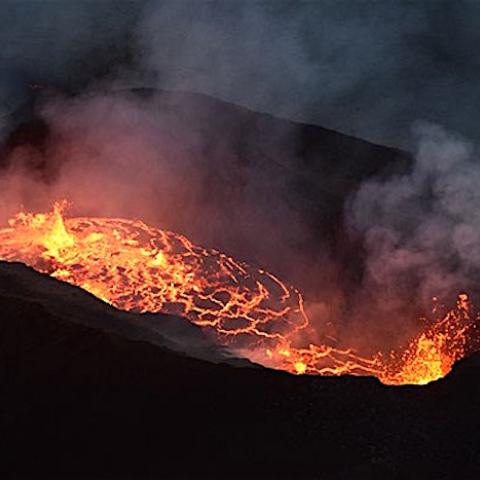Editor's note:Volcano Watch is a weekly article and activity update written by U.S. Geological Survey Hawaiian Volcano Observatory scientists and affiliates.
The episodic summit eruption of Kīlauea in Halemaʻumaʻu crater has been going on for over three months now, with 16 eruptive episodes displaying lava fountains and lava flows within Kaluapele (the summit caldera). What clues can observations of sparse episodic eruptions in Kīlauea’s past tell us about the ongoing episodic eruption at Kīlauea summit?
Similar episodic eruptions at Kīlauea took place in 1959 (Kīlauea Iki), 1969 (Maunaulu), and from 1983–1986 (first three years at Puʻuʻōʻō). An understanding of what happened before and after these similar eruptions on Kīlauea, as well as how the eruptions themselves progressed, can inform our understanding of the ongoing summit eruption.
An important consideration is how pressurized the magma chambers beneath Kīlauea summit are. One tool that scientists at the USGS Hawaiian Volcano Observatory (HVO) use to measure pressurization in magma chambers is tiltmeters. Tiltmeters can detect very small changes in how the ground is tilting around Kīlauea summit. While tiltmeter technology has changed over time, the measurements haven’t. As pressure accumulates in the magma chambers (inflation) beneath the ground surface, the ground surface bulges outwards and tiltmeters track these subtle changes in ground tilting over time.

Ground tilt associated with episodic eruptions at Kīlauea. Top panel, two years of summit tilt spanning episodic fountaining at Maunaulu in 1969, as measured by a watertube tiltmeter at Uēkahuna bluff. Middle panel, an ideal aerosmith measurement of summit ground tilt during the initial years (1984-1986) of the Puʻuʻōʻō eruption that span a period of episodic fountaining. Bottom panel, electronic borehole tiltmeter record from December 2024 until April 2025 showing strong deflationary tilt associated with the sixteen (so far) eruptive episodes, numbered on the graph.
Leading to the 1959 summit eruption of Kīlauea Iki, the magma chambers beneath Kīlauea summit region had been refilling and repressurizing for years following the 1955 lower East Rift Zone eruption. Following the 1959 eruption, which consisted of seventeen high fountains every couple of days over about a month, pressure within Kīlauea’s summit magma chambers had only increased.
The twelve episodic lava fountains at Maunaulu, on the upper East Rift Zone of Kīlauea in 1969 followed several brief summit and East Rift Zone eruptions which were preceded by rapid inflation of the magma chambers beneath Kīlauea summit. Before those events, Kīlauea summit had been in a prolonged lava lake eruption from 1967–1968 that was accompanied by little ground deformation. Similar to during the 2025 eruption, the summit magma chambers deflated during Maunaulu lava fountaining episodes, which happened days to weeks apart, and inflated during pauses. After the episodic lava fountaining phase of Maunaulu ended, it entered a multi-year phase of lava flows building a shield and traveling downslope towards the ocean.
Prior to the Puʻuʻōʻō eruption on the middle East Rift Zone of Kīlauea, there had been several years of summit eruptions and rift zone intrusions on Kīlauea and overall inflation of Kīlauea’s summit. Like the Maunaulu eruption, the phase of 44 lava fountains (occurring about once a month over about three years) was followed by lava flows building a shield and traveling downslope towards the ocean. Kīlauea summit deflated with the onset of the Puʻuʻōʻō eruption, and that deflation continued for the next two decades as the Puʻuʻōʻō eruption continued.
During the ongoing eruption, tiltmeters have shown inflationary tilt prior to a lava fountaining episode, as pressure builds beneath the surface, and a switch to deflationary tilt when a lava fountain episode begins, indicative of the pressure within the magma chambers being released.
This pattern of inflation and deflation with every recent lava fountain episode creates a saw-tooth pattern in ground tilt records over the past several months; however, Kīlauea summit has shown little net change in pressurization since the eruption began on December 23, 2024. This indicates that Kīlauea summit has been in some level of equilibrium since the eruption began. The north and south eruptive vents in Halemaʻumaʻu are able to incrementally release the pressure that accumulates within Kīlauea summit magma chambers with each eruptive episode.
As long as that equilibrium is maintained, the episodic eruption at the summit of Kīlauea is likely to continue. The ongoing eruption patterns have also allowed HVO staff to publish windows of probability for when future eruptive episodes could begin. Changes such as a decrease in the rate of inflation or a severe blockage of the vents could alter the current pattern of fountaining episodes, including bringing them to an end. HVO will continue to closely monitor the activity, especially the amount of pressurization of Kīlauea’s summit magma chambers, for any changes that could herald a potential change in eruptive activity.




 Support Essential Coverage of Essential Places
Support Essential Coverage of Essential Places






